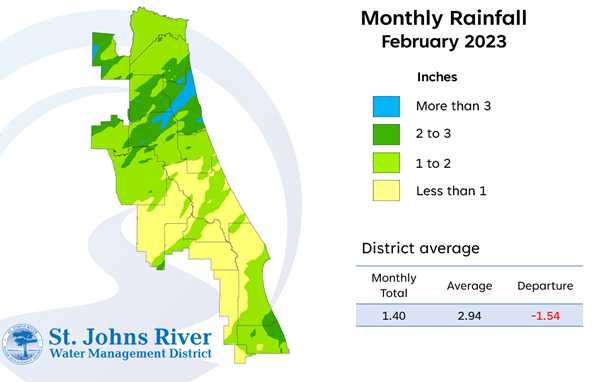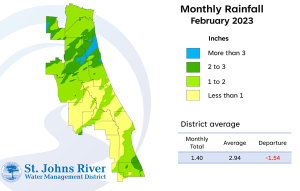District experiencing moderate drought conditions

A map illustrates rainfall conditions in February across the St. Johns River Water Management District.
PALATKA, Fla., March 14, 2023 — The St. Johns River Water Management District’s 18-county region is experiencing moderate drought conditions, according to the U.S. Drought Monitor. The entire region, except for a band through St. Johns, Clay, Putnam and western Baker counties, experienced below-average rainfall in February. Central Florida was particularly dry, with large areas receiving less than one inch of rain.

A map illustrates rainfall conditions in February across the St. Johns River Water Management District.
Although drought conditions are present, overall water resources are in a healthy condition, as we enter our dry season. A full report outlining February’s hydrologic conditions was presented at the District’s Governing Board meeting Tuesday. Highlights include:
Rainfall
- Districtwide, February rainfall averaged 1.40 inches, which is 1.54 inches below the average for the month.
- Districtwide, the cumulative rainfall total for the past 12 months is 54.62 inches, which is 3.61 inches above the long-term average.
- There were six counties with county-wide totals less than one inch: Lake, portions of Orange, Osceola and Okeechobee, and Volusia and Seminole counties.
- Even though central Florida has had a rainfall deficit for the last couple of months, the total 12-month rainfall in the central region of the District is still well above average due to the extreme rainfall from last year’s tropical systems.
Groundwater
- At the end of February, Upper Floridan aquifer conditions (groundwater levels) throughout most of the District were in the normal range with isolated areas where conditions were in the high range.
- Groundwater levels expressed as a single districtwide index are at the 57th percentile, which is at the high end of the normal range for this time of year.
Spring flows
- The mean monthly flow at Silver Springs remains in the normal range at 619 cubic feet per second (cfs), or 400 million gallons per day (mgd), which is a 15 cfs decrease from January’s mean.
- At the Blue Spring station in Volusia County, the mean monthly flow was 158 cfs, or 102 mgd, which is in the normal range.
- At Rock Springs, the monthly mean flow remains in the high range with a decrease of 2 cfs to 63 cfs (41 mgd).
- Mean monthly flow at Wekiwa Springs also remains in the high range for this time of year at 73 cfs (40 mgd).
To learn more about rainfall totals and other hydrologic data collected, visit www.sjrwmd.com.
Visit WaterLessFlorida.com for tips to help landscapes thrive while saving water and money. Follow the water conservation conversation at #sjrwmd #waterconservation #savewater.

